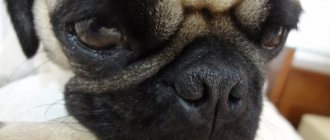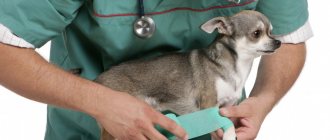Basic causes of lacrimation
The large and expressive eyes of a Chihuahua are a vulnerable place for the development of pathogens.
The thing is that the breed often has watery eyes. Many breeders associate increased tear production with the location and size of the eyeball. Indeed, there is a large grain of truth. However, if a Chihuahua's eyes water profusely and constantly, then most likely the dog has health problems or an allergic reaction to environmental irritants, i.e. allergens.
Lack of care for teary eyes invariably leads to damage to the mucous membrane of the eyeball, and surrounding tissues, by bacterial or fungal microorganisms.
One of the dangerous eye infections is conjunctivitis.
If you notice dark brownish-red circles (spots or tracks) under your Chihuahua’s eyes, then it’s time to start preventing and treating the problem. First, you should identify the causes of watery eyes in Chihuahuas. Self-diagnosis is quite difficult without medical education, so it is wiser to trust a veterinarian.
Based on canine observations, 20-25% of all toy dogs have tear stains. In Chihuahuas, the cause is due to small eye sockets but large eyeballs. Due to shallow eye sockets, tears do not sufficiently wash the eyes through the tear ducts, so they periodically water from drying out and lack of nutrients to the cornea.
In addition to the fact that the breed is predisposed to tearing, a fairly common cause of this condition is a pathological excess of tear fluid, known as epiphora. However, this is far from the only cause of watery eyes in Chihuahuas, so let's look at them all:
- Eye diseases: conjunctivitis, glaucoma, cataracts, keratitis and others.
- Puppy teething. Tearfulness is observed both during the eruption of primary and molar teeth.
- Trichiasis or entropy. In the first case - abnormal growth of eyelashes in the direction of the eyeball, in the second - inversion of the eyelid in the same direction, i.e. inside.
- Ear or nasal diseases. Tears may indicate a runny nose (cold), rhinitis, or an ear infection (such as otitis media) or ear mite infestation.
- Allergic reaction. Allergies can occur both to ingredients in everyday food and to surrounding allergens. For example, on a plastic bowl, so it is recommended to use a metal or ceramic one. Also, the fluffy bedding of a sun lounger can become an allergen, so it is better to use smooth fabrics.
- External irritants: wind, sunlight or bright artificial light, smoke, foreign matter getting into the eyes (dust, own hair, midges, etc.).
- Tap water. A dog's consumption of unfiltered tap water can cause watery eyes due to the high content of chemical impurities in it.
- Poor nutrition. Budget food with a high content of low-quality food, consisting mainly of processed ingredients, so-called food fillers, can result in increased tearing due to an allergic reaction to food components.
- Blocked tear ducts. The problem may be caused by an infection, a tumor, or blockage of the tear ducts by foreign bodies. For example, dirt, small grains of sand, thereby preventing the normal outflow of tear fluid. Either one eye or both can become watery.
- Congenital defect. There are cases when Chihuahua puppies are born with blocked or too narrow tear ducts.
As you can see, watery eyes in a Chihuahua do not always signal health problems. In most cases, moderate lacrimation is a normal breed phenomenon if it is not accompanied by negative symptoms:
- red and swollen eyes;
- purulent discharge with an unpleasant odor;
- tears are cloudy and unclean;
- abnormally excessive tearfulness;
- clouding of the cornea or pupil;
- itching of the eyeball.
If any of the symptoms are present, contact your veterinarian immediately for examination. Otherwise, the consequences can be dire, including complete loss of vision in the dog.
Causes of lacrimation in small breed dogs
Dogs of decorative breeds with large eye sockets or long hair are especially prone to the problem of lacrimation. In the first case, the tendency is due to the anatomical form and heredity (because of this, Chihuahuas have watery eyes). In the second, hairs get into the mucous membrane.
Interesting! The cause of the pathology can also be an open third eyelid, which is typical for mastiffs and basset dogs.
Profuse tears are a common problem in pugs, Yorkshire terriers, Pekingese, Shih Tzu, poodles, and spaniels. Usually the problem is solved by intensive eye socket care (regular rinsing with lotion, cutting off too long hairs).
When, in addition to the fact that the Spitz's eyes are watery, there is suppuration, the pet feels pain or discomfort, you need to contact a veterinarian to diagnose the problem. This may be one of the symptoms of infectious diseases.
Entropion of the eyelids
The disease is not typical for the breed. More often, this pathology occurs in dogs with an abundance of skin folds on the face. But it happens that the corner of the upper eyelid also turns in on Spitz dogs.
The problem appears in the first year of life. It can only be treated with surgery.
- redness;
- visible deformation;
- painful condition;
- possible appearance of suppuration;
- eyes run and water.
Districhiasis
Streaks of tears around the eyes are a common problem in Spitz dogs with districhiasis - pathologically abnormal eyelash growth. The problem is hereditary, so when purchasing, it is important to find out all the problem areas of the puppy’s parents.
If your Spitz's eyelashes are soft, then no treatment will be required. If the hairs are hard and come into contact with the cornea, then regular plucking of abnormally growing eyelashes and instillation of an anti-inflammatory drug (Tsiprovet) is necessary.
Conjunctivitis
Inflammation of the conjunctiva is also accompanied by lacrimation. It develops against a background of weakened immunity and due to the constant contact of hair on the cornea.
Also, the appearance of conjunctivitis in a Spitz is influenced by eye injuries, infectious and colds, ingrown eyelashes, metabolic disorders, and fungi.
There are several types of disease:
- follicular conjunctivitis (inflammation of the third eyelid with the formation of bubbles with liquid - follicle);
- purulent (inflammation of the conjunctiva with purulent discharge, while clear tears flow from the eyes);
- allergic;
- catarrhal (the mildest type, often goes away without treatment, appears due to injury or systemic exposure to eyelashes and hair).
Inflammatory process in the body
Watery eyes in a Spitz can be a symptom of such a dangerous viral inflammation as canine distemper. It is usually accompanied by copious purulent discharge from the mucous membranes.
Interesting! The eyes also run with otitis media. Colds or infectious inflammations of the ear canals cause disturbances in the functioning of the lacrimal canaliculi and sacs.
Pathologies associated with tear drainage
Watery eyes in a Spitz puppy may be a sign of pathology of the tear ducts. These are congenital problems that are inherited.
- The most common disease is atresia, or the absence of one or both lacrimal openings.
- Tear duct obstruction is characterized by blockage of the ducts, causing bacterial invasion and abscess. It is observed with atresia, frequent injuries to the mucous membrane and herpes virus infection.
- A rare disease for Spitz dogs is dacryocystitis - inflammation of the lacrimal sac. It appears in puppies from 6 to 12 months due to blockage of the nasolacrimal canal with embryonic tissue. Stagnation of tears accumulates particles of dust and bacteria, forming an abscess, which is removed surgically.
- Obstruction of the nasolacrimal duct due to deformation of the muzzle (too short facial part in Pomeranians is now in fashion). This cannot be corrected, so it is better to buy puppies that meet breed standards.
General signs of the disease
The most striking harbingers of Chihuahua health problems are the following symptoms:
- elevated temperature – above the norm, which is 38-39 degrees;
- rapid breathing;
- the dog is vomiting;
- eyes water;
- discharge from the nose, ears;
- diarrhea;
- loss of appetite, even to the point of refusing food;
- weight loss;
- cough;
- presence of parasites;
- dandruff;
- itching;
- lameness;
- sudden convulsive attacks.
If such symptoms appear in a Chihuahua, you should immediately be wary. If you doubt what exactly your dog is sick with, then there is no need to self-medicate. Better consult your veterinarian.
Let's look at the most common Chihuahua diseases and the health problems that they entail. And most importantly, what to do at the first signs of illness in your dog.
Chihuahua eye care
The doctor will conduct the necessary research and reliably determine the true cause of tearing, prescribe the correct treatment, and give recommendations for further care for the dog’s eyes.
It is not always worth panicking and running to the veterinary clinic. If the tear secretions are clear, without an unpleasant odor and signs of purulent inflammation, and the eyes are clear, without redness or swelling, then there is nothing to worry about. It is enough to remove tear accumulations with a clean and soft cotton cloth or a cotton pad moistened with a weak chamomile infusion or a specialized dog lotion for eye care. The procedure is recommended to be carried out daily, but at least 3 times a week.
Beginning Chihuahua owners are sometimes alarmed by the eyes of this dog with their tearfulness. In fact, this is a common occurrence for this breed. But in this regard, caring for the eyes of a Chihuahua requires some skills. A slight light discharge is normal, but if you notice that your Chihuahua’s eyes have begun to fester or your Chihuahua’s eyes are watering too much, this is a reason to visit the veterinary clinic.
We suggest you read: What to feed a dog or puppy with diarrhea
To prevent the hair from deteriorating due to tears and dark streaks appearing under the eyes, try to remove the crusts that form there from time to time. These secretions are a good breeding ground for a variety of bacteria, so if a Chihuahua has watery eyes, you need to keep an eye on the cleanliness of the dog’s eyes if you don’t want bacteria to give rise to the development of conjunctivitis and other eye diseases.
To wash the eyes, a weak solution of boric acid, chamomile decoction or tea leaves are most often used. Moreover, the latter remedy, due to its ability to color the coat, is recommended for dogs with dark hair, and chamomile decoction, on the contrary, for dogs with light hair. The procedure is performed as follows: take a cotton pad or swab (gauze or any other soft cloth will also work), moisten it in the chosen product, squeeze it a little and, moving from the outer corner to the inner one, wipe the dog’s eye.
In some cases, it becomes necessary to rinse the Chihuahua's eyes. For this purpose, purchase lotions to cleanse your dog's eyes from your veterinary pharmacy. Carefully bringing the bottle to the eye, rinse the eye, and then use the same movement as when wiping.
Rinsing helps clear the eyeball of dust and foreign small particles that can injure it. Red eyes in a Chihuahua can let you know that something is wrong with your pet.
Chihuahuas' eyes often water, this is normal for them.
The main thing is to ensure that the discharge from the eyes does not become abundant or change color. If this happens, you must immediately contact a veterinarian!
Often after sleep, mucous stains form under the eyes of a Chihuahua, which, after drying, become like crusts. They must be removed, as they are a favorable environment for the proliferation of microbes, which can lead to conjunctivitis or other diseases of the animal’s eyes.
You can quickly and easily wash your Chihuahua's eyes using a cotton swab moistened with a weak solution of boric acid, chamomile decoction or tea leaves. You should rinse from the inner corner of the eye, towards the outer corner, following the growth of the fur.
In addition to treating the skin around the eyes and removing crusts that have formed, it is sometimes necessary to wash the eyes themselves. For this, it is best to use special lotions, such as Oftolavas or Clean eye. With one hand, open the dog's eyelids, and with the other, bring the bottle with the solution. Bring the bottle from behind the animal’s head, from above, so that the dog does not see it and is not afraid.
If, after rinsing with any product, you notice that the condition of your Chihuahua's eyes has worsened, contact your veterinarian immediately!
It is recommended to wash your Chihuahua's eyes in this way at least once a day, preferably in the morning, immediately after sleep. You can also rinse your eyes after a walk in windy weather if your eyes begin to water again due to dust.
If your pet's eyes regularly cry, contact your veterinarian for advice, you may need to change his diet. Sometimes, regular tearfulness occurs in dogs that eat commercially prepared food. This may mean that this brand of food is somehow not suitable for your little friend, and the Chihuahua's tearfulness may be a sign of an allergic reaction; perhaps you should try a different food or switch to homemade food.
To summarize, we note that a normal phenomenon for a Chihuahua is tearfulness after sleep, during spring shedding, when fur gets into the eyes, in windy weather, when dust and sand can get into the eyes. Discharge from a Chihuahua's eyes should be clear, like a tear, but the crusts under the eyes are often dark, brownish in color.
However, there is no need to panic, just rinse your eyes as needed. If dark, brown spots under the eyes do not go away, you can purchase special creams, gels or lotions that are sold at any pet store. These products are aimed more at an aesthetic effect than any kind of prevention or treatment; they help lighten the hair under the eyes.
Chihuahua Eye Care (Part 2)
Why do Chihuahuas have watery eyes?
After the procedure, be sure to dry the hair around the eye with a dry cloth or clean towel, removing excess liquid. You need to clean your eyes as they become dirty, but ideally perform these simple manipulations daily. This will help you avoid eye diseases.
But regular excessive tearing is a symptom of the disease, in this case you should take your pet to a veterinary clinic. If, after using the lotion or any other product mentioned above, you notice that your Chihuahua’s eyes are running more or the nature of the discharge has changed (the color has changed, the smell has changed, etc.), this is also a reason to show the dog to a specialist doctor. By the way, veterinarians do not recommend using fluffy materials (fluffy flannel, cotton swabs, etc.) to care for a dog’s eyes, since individual fibers can get on the eyeball and cause serious irritation.
Author of the article: Maria Mikhailova
Articles on similar topics:
History of the Chihuahua breed Coat care for long-haired and smooth-haired Chihuahuas Description of the Chihuahua
Chihuahua dental care Feeding the Chihuahua Vaccination of the Chihuahua Chihuahua paw care
Eye diseases in Chihuahuas
Preventive measures are aimed at preventing fungal, viral or bacterial eye diseases of the dog.
Prevention involves periodically (daily) removing tear tracks under the eyes with a damp cloth or cotton pad. Excel Tear Stain Remover Liquid lotion (American) has a good antiseptic and cleansing effect. Price: 250-300 rubles.
At least 2 times a week, you should wash your eyes using specialized or folk remedies (a weak infusion of chamomile or black tea).
Regularly check your Chihuahua's eyes for microtrauma, inflammation, suppuration, swelling, tumors and other abnormal abnormalities.
Normal tear secretions are odorless and crystal clear.
Does your Chihuahua dog have watery eyes? How often do you wipe your tear tracks? And are you doing this at all?
If this doesn’t help, it’s time to contact a specialist. Experimenting with the selection of medications on your own is dangerous. This can cost your pet’s health, including deterioration or loss of vision.
Tests taken at the clinic will reveal an infection or a lack of vitamins or microelements. If there is an infection, the veterinarian will select the right medicine; in case of vitamin deficiency, he will offer a corrective course of vitamins and nutritional supplements.
Profusely watery eyes in the presence of additional signs, for example, redness of the whites, redness of the eyelids, itching, purulent discharge, may indicate the presence of diseases such as:
- conjunctivitis;
- kerato-conjunctivitis;
- inflammation of the middle age;
- eyelashes that curl inward;
- glaucoma.
We invite you to familiarize yourself with: Chihuahua puppy weight table by week
Conjunctivitis occurs as a result of mechanical damage to the cornea or eyelid. If you do not pay attention to this in time, the watery eye turns red, the tissues of the eyelids become inflamed, and more complex forms of conjunctivitis may develop:
- Purulent conjunctivitis. Its causative agents are microorganisms that usually live peacefully in the conjunctival sac. When the immune system fails, they are activated, causing purulent discharge from the eye.
- Follicular conjunctivitis. It proceeds unnoticed, becoming chronic. An advanced disease leads to deformation of the dog's eyelids.
- Fibrous conjunctivitis. This is a consequence of thermal or chemical burns, the distemper virus. It manifests itself as rashes on the conjunctiva, penetrating into its deep layers.
- Phlegomonous form. A rare disease in which the conjunctiva and subconjunctival tissue are affected. In the latter, hemorrhages occur. The conjunctival membrane becomes dense and as if “varnished”, the eyeball protrudes.
- Kerato-conjunctivitis - “dry eye syndrome” occurs when the production of tear fluid is reduced. Due to lack of moisture, the cornea dries and becomes thinner. The disease is extremely dangerous and without proper treatment can lead to loss of vision.
Watery eyes due to inflammation of the middle eyelid are characterized by ulceration or itching of the eyelids. The cause of the disease may be vitamin deficiency, the ingestion of foreign objects (the same villi from unsuitable bedding), irritation from dust.
Glaucoma - a disease caused by increased intracranial pressure, which is typical for Chihuahuas (certain skull structure, not overgrown fontanel, weather dependence, etc.)
Another cause of leaky eyes in Chihuahuas is improperly growing eyelashes. They bend inward and scratch the cornea, causing microtrauma. You may not be able to see this on your own, but it’s worth keeping in mind.
When visiting a veterinary clinic, it is advisable to show the dog to an ophthalmologist or, if there is no such specialist in the clinic, ask the attending doctor to examine the watery eyes for ingrown eyelashes.
The eyes are an important organ; it is dangerous to leave any changes in their appearance to chance. It’s better to play it safe and take your animal to the veterinary clinic one more time than to treat the dog for a long time or even lead to disability.
The Chihuahua has slightly protruding eyes that are larger than those of many dogs. Due to this unusual shape of the eyeballs, symptoms of many eye diseases can often be found in dogs of this breed:
- keratoconjunctivitis is a disease that causes dry eyes;
- glaucoma is a disease that develops due to increased pressure inside the eyeball;
- cataract is clouding of the lens.
If your dog's eyes are watery or running, redness is visible, he constantly blinks and rubs his eyes, and his eyes become too dull in color, then he is showing signs of eye disease.
What to do: urgently contact a veterinarian-ophthalmologist. He will conduct the necessary diagnostics and prescribe treatment. The main thing is to be on time, otherwise serious consequences may arise, from the need for surgical intervention to complete blindness.
Chihuahuas sometimes lose their eyes. This pathology can occur if the pet's head has been subjected to mechanical damage. Representatives of this breed have a shortened skull structure, and the eyeballs last only for centuries, so eye loss is a common occurrence.
The most striking symptom of this problem is protrusion of the eye. If the eyes are watering, bleeding, and the dog is afraid of light, then before going to the hospital you need to take some measures.
First, you need to keep the dog calm and try to keep his paws away from his eyes. A special collar or suitable clothing is perfect for this purpose.
Second, gently wipe the affected eye with saline solution. No antiseptics: no alcohol, no hydrogen peroxide. After this, lubricate the eye with a large amount of suitable ointment - tetracycline or floxal.
Third, apply something cold for fifteen minutes to relieve swelling. Then cover the damaged area with a wet cloth.
Prevention of eye diseases in Chihuahuas
Prevention Tips:
- Drops and medicated lotions are used for rinsing, and excess liquid is wiped off from the fur and eyelids.
- The animal is examined after walks, the eyes are treated with a cotton pad soaked in saline solution.
- Corneal irritation occurs in long-haired pets. For prevention, a haircut is carried out, the dog’s diet is changed, health and immunity are strengthened.
Skull injuries or sudden movements lead to eye loss. In this situation, the organ of vision is inserted into place, bandaged, and the animal is sent to the doctor.
Chemical composition and functions of tears
Tear is a slightly alkaline secretion secreted by the lacrimal glands. Its chemical composition includes: water (more than 95%), mucin, lipids, lysozyme, porphyrins, and other trace elements.
The porphyrin molecule contains iron, which colors tear stains in dark red and brown tones as a result of oxidation, which is most noticeable in light-colored individuals. For example, white, red, fawn, cream. It is the owners of dogs of the listed colors who often notice that their Chihuahua's eyes water, forming dark tear tracks on the fur under the lower eyelids. What to do? Carefully wipe away any stains! We'll talk about the reasons below.
Tear performs a moisturizing, cleansing and protective function of the eyeball from external irritants:
- wind or artificial air flow;
- sun rays and bright light;
- bacteria and microorganisms;
- foreign bodies (dust, wool, etc.).
And if in humans tears often appear as a result of emotional shock, including as an antidepressant, then in animals such a reaction is excluded. That is why when a person cries, he feels better.
In addition, tears perform the important task of transporting nutrients to the cornea of the eye. Deviations from the normal functioning of the lacrimal apparatus lead to visual impairment, up to complete blindness, and the development of a favorable environment for the proliferation of pathogenic bacteria on the surface of the conjunctiva. Therefore, it is important to take care of your Chihuahua's eyes to keep them healthy and expressive!
Excessive dryness of the mucous membrane and redness of the eyeball, swelling (edema), profuse and prolonged lacrimation are a cause for concern and an immediate visit to a veterinarian.
Unexplained cough
If your pet is coughing, there may be several reasons. The unusually short structure of the head of Chihuahua dogs does not allow them to breathe deeply, especially during a sharp transition from a calm state to an excited one.
We suggest you read: Eye diseases in cats











